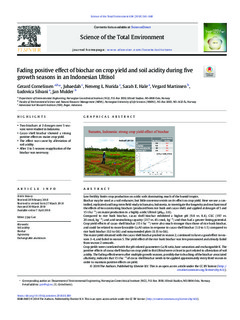| dc.contributor.author | Cornelissen, Gerard | |
| dc.contributor.author | Jubaedah, X | |
| dc.contributor.author | Nurida, Neneng | |
| dc.contributor.author | Hale, Sarah | |
| dc.contributor.author | Martinsen, Vegard | |
| dc.contributor.author | Silvani, Ludovica | |
| dc.contributor.author | Mulder, Jan | |
| dc.date.accessioned | 2018-09-04T10:38:50Z | |
| dc.date.available | 2018-09-04T10:38:50Z | |
| dc.date.created | 2018-04-09T10:07:12Z | |
| dc.date.issued | 2018 | |
| dc.identifier.citation | Science of the Total Environment. 2018, . | |
| dc.identifier.issn | 0048-9697 | |
| dc.identifier.uri | http://hdl.handle.net/11250/2560667 | |
| dc.description.abstract | Low fertility limits crop production on acidic soils dominating much of the humid tropics. Biochar may be used as a soil enhancer, but little consensus exists on its effect on crop yield. Here we use a controlled, replicated and long-termfield study in Sumatra, Indonesia, to investigate the longevity andmechanismof the effects of two contrasting biochars (produced fromrice husk and cacao shell, and applied at dosages of 5 and 15 t ha−1) on maize production in a highly acidic Ultisol (pHKCl 3.6). Compared to rice husk biochar, cacao shell biochar exhibited a higher pH (9.8 vs. 8.4), CEC (197 vs. 20 cmolc kg−1) and acid neutralizing capacity (217 vs. 45 cmolc kg−1) and thus had a greater liming potential. Crop yield effects of cacao shell biochar (15 t ha−1) were also much stronger than those of rice husk biochar, and could be related to more favorable Ca/Al ratios in response to cacao shell biochar (1.0 to 1.5) compared to rice husk biochar (0.3 to 0.6) and nonamended plots (0.15 to 0.6). Themaize yield obtainedwith the cacao shell biochar peaked in season 2, continued to have a good effect in seasons 3–4, and faded in season 5. The yield effect of the rice husk biochar was less pronounced and already faded from season 2 onwards. Crop yieldswere correlatedwith the pH-related parameters Ca/Al ratio, base saturation and exchangeable K. The positive effects of cocoa shell biochar on crop yield in this Ultisolwere at least in part related to alleviation of soil acidity. The fading effectiveness aftermultiple growth seasons, possibly due to leaching of the biochar-associated alkalinity, indicates that 15 t ha−1 of cocoa shell biochar needs to be applied approximately every third season in order to maintain positive effects on yield. | |
| dc.description.abstract | Fading positive effect of biochar on crop yield and soil acidity during five growth seasons in an Indonesian Ultisol | |
| dc.language.iso | eng | |
| dc.title | Fading positive effect of biochar on crop yield and soil acidity during five growth seasons in an Indonesian Ultisol | |
| dc.title.alternative | Fading positive effect of biochar on crop yield and soil acidity during five growth seasons in an Indonesian Ultisol | |
| dc.type | Peer reviewed | |
| dc.type | Journal article | |
| dc.description.version | publishedVersion | |
| dc.source.pagenumber | 8 | |
| dc.source.journal | Science of the Total Environment | |
| dc.identifier.doi | 10.1016/j.scitotenv.2018.03.380 | |
| dc.identifier.cristin | 1578250 | |
| dc.relation.project | Norges forskningsråd: 217918 | |
| dc.relation.project | Norges forskningsråd: 243789 | |
| cristin.unitcode | 7452,5,2,0 | |
| cristin.unitname | Forurensning og arealutvikling | |
| cristin.ispublished | true | |
| cristin.fulltext | original | |
| cristin.qualitycode | 2 | |
